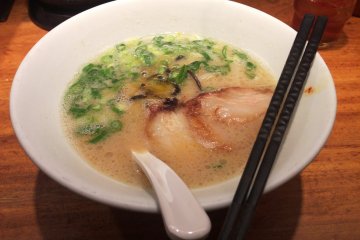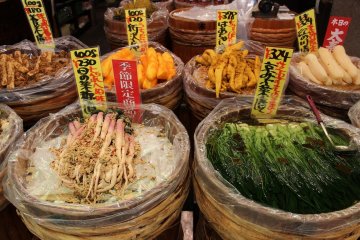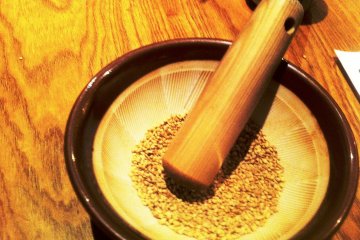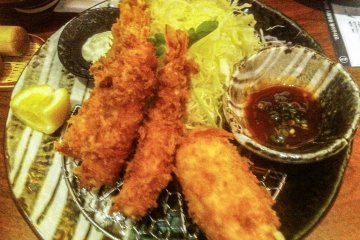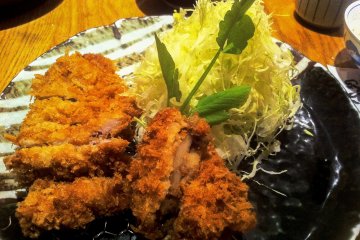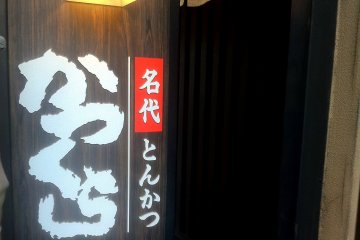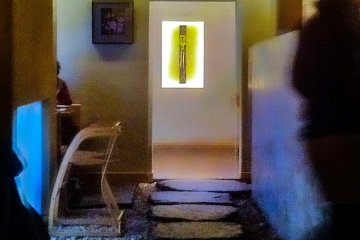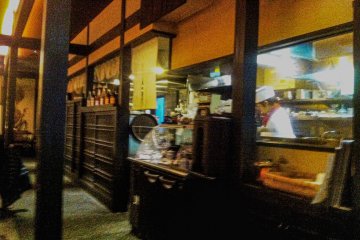Sometimes it is the simple things in life that bring that moment of contemplation, like the grinding of goma (sesame) seeds just before our meal at Katsukura. In a time when most city folk have lost touch with their earthly roots with farms and Mother Nature, the bonding with the texture and aroma of Goma, brings back many happy memories of country kitchens, long before farm to kitchen culinary journeys were popularized in popular media.
In the TV show “Eight weeks to happiness”, the art of mindfully meditating on one activity, whether it is the wholehearted chewing of a grape, or being mindful of your surroundings, is one of the secrets of happiness. When you feel the smooth wood grain of the Japanese cypress pestle in the palm of your hand, the quiet joy of making your own ground goma paste, like an artist making her dye for the very first time, you can easily enter this moment of peaceful contemplation.
Once the goma has been grounded to your level of smoothness, you can add color and spice with one of Katsukura’s original sauces. Select from either the sweet flavor of the red wine, apple and vinegar sauce, which reminds me a bit like okonomiyaki sauce, or the eleven spice sauce, which had me hooked even though it refuses to be pigeonholed into any genre, being equally balanced between sweet, savory and spicy at the same time. Of course if you can't decide between the two, you can always have both one after the other, or even at the same time!
Katsukura has a number of branches in Kyoto, and today we had a late lunch at the Shijo restaurant. On a side street north of Shijo street near Kurasama Hankyu railway station, it has been welcoming foreign travelers for a long time. During the week the restaurant can be busy between 12pm and 1pm with office workers, so be prepared for a five to ten minute wait if you are arriving between 1210 and 1pm. Our party of four dropped in at 4pm, and the beauty of most Japanese eateries is that they serve lunch even late in the afternoon, so this is a great place to relax after a day of sightseeing.
The décor at Shijo is reminiscent of a Machiya, or a Kyoto Merchant Townhouse. If you step back a hundred years in time, machiyas have an open kitchen on one side away from the house to minimize fire risk and for the big charcoal cooker to do its work cooking rice that most Japanese grandmothers would reminisce about. Between the kitchen and the living rooms machiyas traditionally have an uninterrupted alleyway for the barrels of produce or merchandise to be rolled in to the Kura (or warehouse) at the back. Here in the restaurant you can see the open kitchen as well as the “alleyway”, and even though the whole restaurant is inside seating, it remains light and airy with a mixture of modern and nostalgia in natural wood colors. Luckily you don’t have to sit zazen style on your knees like you do in an authentic tatami mat sitting room, there are plenty of western tables and chairs for those with weak knees, almost in a booth like set up without the feeling of being closed in.
The crowd is buzzy without being noisy, with quiet conversation for on their short wait for their made to order meals, and those in quiet contemplation or state of bliss being totally mesmerized by the visual and textual beauty of their meals.
There is a good mix of office workers, tourists and charming grandparents clutching their day packs and felt bowler hats, on their way back from seeing their grandchildren starting school for the first time. I only wish that I can be so intimate and wholesome after forty years of marriage.
English and picture menus are available, and the sauce explanation card has English on one side and Korean on the other.
For around 1000 yen you can have a hearty meal of Pork Tonkatsu (like a Japanese Schnitzel) plus unlimited refills of cabbage salad, rice and miso soup, so even with an appetite of a teenager or a sumo wrestler, this place is great value. While it is nearly impossible for a chain restaurant like this to win Michelin star status, the consistency and quality is good enough even for fussy eaters.
My pick, being a prawn fanatic, would be the prawn tempura, but the surprise of the day was the tofu croquettes, hot, creamy and light at the same time, it is a fantastic combination of taste, and delicate airy breadcrumbs. Kyoto is famous for its tofu, and with its fresh spring water and a long agricultural heritage, should be tried at least once during your stay. I also tried the country potato croquettes, which balance well with the grain fed pork or sirloin fillet Tonkatsu.



